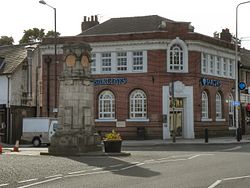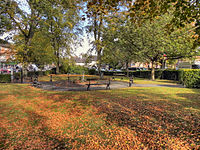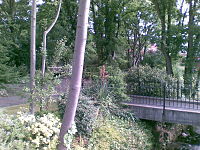Gatley
| Gatley | |
| Cheshire | |
|---|---|
 The war memorial and clocktower at Gatley | |
| Location | |
| Grid reference: | SJ853881 |
| Location: | 53°23’40"N, 2°14’49"W |
| Data | |
| Post town: | Cheadle |
| Postcode: | SK8 |
| Dialling code: | 0161 |
| Local Government | |
| Council: | Stockport |
| Parliamentary constituency: |
Cheadle |
Gatley is a village of Cheshire which has become a suburb within the conurbation attached to Stockport. Gatley sits between Wythenshawe to the west and Cheadle to the east, caught within the road systems: the M60 motorway slices across its north and the A34 dual carriageway across the west, with their junction and the crossing of two railway lines taking up much of what might otherwise have been Gatley.
In 1290, Gatley was known as Gateclyve, which in Old English means "a place where goats are kept".
History
Early history
Until the 20th century, most Gatley residents either worked in the material trades or were farmers. An open field system existed around Gatley in the late 17th century, but the practice of common farming seems to have fallen into disuse when William Tatton allowed tenants to buy their own land.[1]
Gatley Carrs was the lower, marshy ground running down to the River Mersey and West to Northenden. Before 1700 it was a place for ozier beds which local people had used for basket making or for wattles for cottages or fencing.
In 1800, Mr Worthington of Sharston Hall planted 1000 poplars in Gatley Carrs.[2] In the mid 19th century, Gatley Carrs was described as "a scene of such singular and romantic beauty, and so thoroughly unique in its composition, that we know nothing in the neighbourhood to liken it to".[3]
Over the years Gatley Carrs has shrunk to a fraction of its former size. In the second half of the 18th century, the Carrs was largely enclosed and partially drained to form farmed meadows. The Stockport to Altrincham railway line cut across it in 1864, running East-West. In 1934 house building began on "High Terrace" of the Mersey (the development behind the Horse and Farrier pub, running down to the railway line) and also about that time Cheadle and Gatley Urban District Council purchased 19 acre to use as a refuse tip. Tree planting commenced due to complaints of smells and rats. There was loss of original field pattern because of extensive refuse tipping.
Carr woodland was developed on what had been carr meadows. There was a major system of land drains identified on the 1934 map including a sluice and non-return outfall gate to protect Gatley Carr from flooding when the Mersey burst its banks.
In the mid 1960s land restoration took place, although the Carr was only covered with soil to a depth varying between 2 inches and 6 inches. Gatley Carrs then fell to the management of the Mersey Valley Countryside Wardens until it was handed to Stockport council in the late 1990s.[4]
Industrial history
Button making appears to have been a significant local trade in the 17th and 18th centuries. A "button man" (merchant selling buttons) is recorded in Gatley in the 1660s. This continued in the 18th century with three button men being mentioned in Gatley between 1735 and 1779.[1]
People living around Gatley Green were mostly hand loom weavers and became more dependent on textile manufacture.[2] Their cottages had cellars for storage and well-lit upper rooms for the looms.[5]
About 1750, William Roscoe from Bolton built a factory near Gatley Hall. (This shouldn't be confused in scale with the cotton mills such as those at Styal: it appears to have been a place for hand weaving and was later converted into a farmhouse, so it was a very modest affair). Up to at least 1841, John Alcock was a textile manufacturer in Gatley, using the Roscoe factory for at least part of the period.[2]
The spread of machinery in industrial manufacturers during the 19th century appears to have killed off industry in Gatley, before which it was a "very busy and important place, as a centre for weaving, spinning, shoemaking and fustian cutting". Handloom weaving may have survived in the area to as late as the 1880s (Melson's Directory of Cheadle, Northenden and Baguley, 1887.[2])
Halls and Houses
In 1714, Stone Pale Hall was reconstructed in Gatley.[2]
Gatley Hall and Gatley Hill House may both have been built in the mid-eighteenth century by local cotton manufacturers. Gatley Hill House is now council owned (Stockport MBC) and is used by various community groups. The mansion High Grove House was built for a member of a wealthy hatting family of Yorkshire and Manchester.[1]
Conflict
In the Civil War (1642–51) the Tatton family, along with the local rectors and most tenants, were Royalists. Wythenshawe Hall was kept in a state of defence from 1642, with Parliamentary forces nearby in Handforth and Duckinfield. Wythenshawe Hall was taken by the Parliamentarian forces on 25 February 1644.[2] Three Gatley men were in the garrison defending the hall: Ralphe Savage, Robert Torkinton and John Blomiley.[6]
On 30 November 1745, about 55 Jacobite soldiers from Bonnie Prince Charlie's army crossed Gatley Ford and Gatley Carrs on their way to Cheadle and Stockport; the bulk of the army crossed the Mersey at Cheadle and Stockport that night and the following day. Having reached Derby but no further, the Jacobite troops were back in Stockport in the second week of December on their way back north.[1]
Gatley residents joined the Luddite riots in 1818, but without any great distinction. They drilled in Gatley Carrs before marching to Stockport to take arms from the soldiers, but returned without actually attempting to do so. In the following summer, 1819, soldiers formed square in front of the Horse and Farrier public house in Gatley with the aim of arresting the Luddite ringleaders. Several ran away and hid (one, Isaac Legh, in the chimney of Stone Pale House, two others in the Carrs).[6]
Churches
A nonconformist meeting house registered in Etchells in 1722 may have been a house in Gatley. In 1777, the Gatley Congregational Church was founded and an independent chapel was built in Old Hall Road, Gatley, following the spread of evangelicalism to nonconformist groups. A full-time minister was employed by the nonconformists for the first time.[1] The present church is on Elm Road.
The first nonconfirmist minister was the Rev. Jeremiah Pendlebury, succeeded by his assistant, the Rev. Samuel Turner, in 1788. By 1860 the church congregation had fallen to eight people. Improvements made with help from the North Cheshire Rural Mission increased the congregation to 60.
Prior to 1875, Gatley's parish church was the Church of St. Thomas, four miles away in Stockport. The people of Gatley rarely saw their parish priest, though they still had to pay their tithes.
The new church, St. James', was built of local handmade bricks and consecrated on Tuesday 6 December 1881. The Rev. Percy M. Herford was the first Vicar of St. James' Church. In 1888 the Rev. P. M. Herford left and was replaced by the Rev. John Bruster, who remained Vicar for 40 years, retiring in 1928.
The vicarage was completed in 1894, following a donation towards it of £100 from Mr W. Heald of Parrswood in 1889.[2] The building is located a short walk away from the church on Northenden Road. The building was sold in 2007 and is now a private nursery.
Gatley has a synagogue, opened in 1968, called Yeshurun Hebrew Congregation.[7] It is a vibrant, Modern Orthodox synagogue, with a thriving membership from Cheadle and Gatley.
Economy and employment
Gatley's primary commercial area covers Church Road, Stonepail Road, Gatley Road, Northenden Road and Old Hall Road. Here there are over 40 shops, 10 take-aways, 8 hairdressers, 4 beauty salons, 4 restaurants, 3 pubs, 4 cafes, 1 bank and significant office space and additional units. Gatley has three smaller areas of local shops on Pendlebury Road, Foxland Road and Silverdale Road, each with between two and six commercial premises.
There are also three small-medium-sized office blocks (on Northenden Road, Park Road, and Stonepail Road) which house various businesses.
Roads and transport
The River Mersey was not bridged in this area until 1745 (and then not continuously as three bridges collapsed over the years) so travelling to Didsbury meant fording the Mersey or crossing in a boat. Until the railway in 1864, the road from Didsbury to Gatley (and then onto Styal) forded the Mersey and came through Gatley Carrs. The "Gatley Ford" was near Didsbury's Millgate Lane, suggesting the river was forded somewhere near the current M60/M56 motorway junction.[6]
Turnpikes opened across Stockport from 1725, with the road through Gatley being amongst the last, in 1820. This was the main road through Cheadle, Gatley, Altrincham and Northwich. By July 1822, the fast coach along the road from Stockport to Liverpool by way of Warrington made it possible to spend six hours in Liverpool and return on the same day.
Gatley had no public transport until 1896, when a postmaster started a cab service. In 1898 Mr Potts began to operate a service to Stockport with a single (horse drawn) omnibus, continuing until the arrival of the electric tram in 1904. Electric trams began to run in Stockport in 1902, with the service to Gatley (terminating at the Horse and Farrier) opening in March 1904. In Gatley, trams were replaced by buses in 1931. The trams were not wholly reliable: broken rear axles were common and the trams often disengaged from the electric cable.
The London and North Western Railway station at Cheadle allowed travel via Edgeley to Manchester, but closed as early as 1917 due to competition with the electric tram between Gatley and Stockport. LNWR opened the "Styal Line" in 1909 including Gatley (as Gatley for Cheadle until 1974) and Heald Green stations.
The M56 and M63 (now the M60) were opened in 1974, bypassing Gatley.
Landmarks and parks

Gatley's war memorial stands on Gatley Green, though the original First World War memorial is the clock tower at the junction of Altrincham Road and Church Road. Following many years of in-operation, a Clock Fund was started in 2011 with the intention of repairing and restoring the clock tower and clock.[8] In mid-2012 work began on restoration, with completion in late 2012. The fully restored clock tower now boasts a fully working clock, however, its four faces are no longer illuminated at night.
The Tatton Cinema was originally built in the 1930s, but now only the front facade still stands. For decades, the cinema was the centrepiece of Gatley, but closed in early 2001 due to the increase in multiplex cinemas, particularly the nearby Parrs Wood Cinema complex which lies 2 miles away. There have been plans to turn the old cinema into a supermarket outlet.
Gatley Recreation Ground (informally known as Gatley Park) is a small park area between Church Road and Northenden Road. It has a bowling green, a hard-surface tennis and basketball court, a children's playground area, and a purpose-built skateboarding area with several ramps.

Walter Stansby Memorial Park is a small tree-lined park area running between Church Road and Northenden Road, near to the Recreation Ground (the two are separated by a children's day nursery). In contrast to the Recreation Ground, it has been designed to be a tranquil nature spot with tended lawns and plants, several memorial benches, and a path that extends through the park.
William Scholes Park lies beside Gatley Hill House. It includes several large playing fields partitioned by small woodland areas. Far larger than Gatley Recreation Ground, this was developed in the early 1960s with money from the William Scholes Foundation. Scholes was a Gatley resident and estate agent who died in 1927. The track circuit opened on 19 May 1962 and was the first home of Cheadle and Gatley Athletics Club, before it merged with Stretford Athletics Club in 1966. Currently, the fields are used for many Gatley events – from the annual Gatley Festival to Sport Relief – and are used regularly by local running clubs as well as local teams for cricket in the summer and football in the winter. A children's playground was opened in February 2011 at the Foxland Road corner.
Gatley Carrs is a Local Nature Reserve[9][10] at the north-west corner of the area (bounded to the north and west by the M60 and M56 motorways and the Stockport-Altrincham railway line). A local community group, the Gatley Carrs Conservation Group, help to maintain the reserve in conjunction with the local authority.[11]
Events
Gatley Festival
Gatley Festival is an annual summer event. It is a celebration of village life and includes a carnival parade and a family fun day which are held on the first Sunday in July each year.
The festival is believed to have started in the early 1930s as the Gatley Rose Queen Parade. The current festival format of a large parade and then a funfair and stalls was started around 1986 and was originally held in what is now known as Gatley Recreation Ground before moving to the much larger Scholes Park next to Gatley Hill House. The festival still maintains the tradition of crowning a Rose Queen.[1]
Music Festival
Gatley Music Festival is a non-profit annual event bringing live music to the village of Gatley, while at the same time raising money for local charities. It runs in March for one week each year with something for every age and taste, including classical, jazz, brass, choral as well as local indie, acoustic and rock. It has its roots in "Music at St James", set up in 1989 by the Rev. Brian Lee (curate of St James in Gatley) and Len Mather. The success of those concerts inspired the establishment of a festival of music in 2005.[2]
Outside links
- Gatley Festival
- Gatley.net
- St James' Church, Gatley
- Gatley Primary School
- Lum Head Primary School, Gatley
- The Kingsway School
References
- ↑ 1.0 1.1 1.2 1.3 1.4 Arrowsmith, Peter "Stockport, A History", published 1997, ISBN 0-905164-99-7
- ↑ 2.0 2.1 2.2 2.3 2.4 2.5 2.6 Shercliff, W.H. "Wythenshawe volume 1: to 1926", published 1974, ISBN 0-85972-008-X Cite error: Invalid
<ref>tag; name "Wyth vol 1" defined multiple times with different content - ↑ Grindon, Leo H. "Country Rambles and Manchester Walks and Wild Flowers, published 1882
- ↑ Research by Gatley Carrs Conservation Group
- ↑ Deakin, Derick "Wythenshawe: The story of a garden city", published 1989, ISBN 0-85033-699-6
- ↑ 6.0 6.1 6.2 Moss, F, "Chronicles of Cheadle". First published 1894. republished by E.J. Morton, 1970, SBN 901598-11-9 Cite error: Invalid
<ref>tag; name "chronicles of cheadle" defined multiple times with different content - ↑ http://www.yeshurun.org.uk
- ↑ "Update on the Clock". GatleyNet News. GatleyNet. http://www.gatleynet.co.uk/gatley-glossary/update-clock. Retrieved 20 July 2011.
- ↑ "Gatley Carrs". Natural England. http://www.lnr.naturalengland.org.uk/Special/lnr/lnr_details.asp?C=0&N=gatley&ID=1143. Retrieved 4 August 2013.
- ↑ "Map of Gatley Carrs". Natural England. http://magic.defra.gov.uk/MagicMap.aspx?startTopic=Designations&activelayer=lnrIndex&query=REF_CODE%3D%271123054%27. Retrieved 4 August 2013.
- ↑ Gatley Carrs Conservation Group